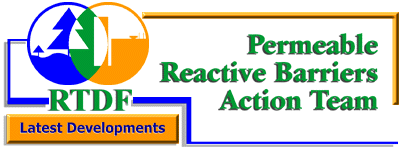 |
|
||||||
|
|
|
||||||
|
|
|||||||
 |
|
||||||
|
|
|
||||||
|
|
|||||||
|
Contaminants: Reactive Media: Cost: Construction: Point of Contact: |
|
|
A full-scale demonstration of a permeable reactive barrier (PRB) to remediate ground water contaminated with trichloroethylene (TCE) was installed in March 1998 at an aircraft maintenance facility in southern Oregon. Historical use of chlorinated solvents for degreasing purposes resulted in the ground-water contamination by TCE and other degradation compounds. Total volatile organic compound (VOC) concentration in the upper aquifer encountered at the site was approximately 500 µg/L. The site is underlain by heterogeneous alluvial deposits ranging from sandy silts to silty gravels. At a depth of 24-34 ft below ground surface (bgs) is a fine-grained aquitard. The depth to the water table varies seasonally between 4 and 8 ft bgs. Average hydraulic conductivity for the alluvial deposits is 3 ft/day. The funnel-and-gate system consists of two gates, each 50 ft wide, and a 650-ft-long funnel. The funnel walls are composed of a 2-ft-thick soil-bentonite slurry installed to the top of the aquitard with a hydraulic conductivity of 0.0003 ft/day. The first gate is composed of two layers, each 50 ft wide and 9 in thick, consisting of 100% zero-valent iron filings. Both layers were installed using a continuous trencher, then connected to the funnel by driven sheet piles. The second gate, upgradient from the first, is 3 ft wide, 60 ft long, and composed of mixed sand and iron filings. It was installed with a trackhoe and drag box. Four monitoring wells, two upgradient and two downgradient, have been installed for each gate. Sampling began in April 1998. Current plans call for sampling every two months for four periods and then quarterly for the foreseeable future. |
![]()
Sponsored by the Technology Innovation Program
Date Last Modified: January 14, 2000